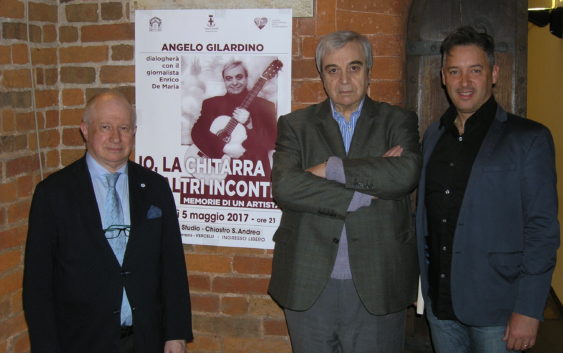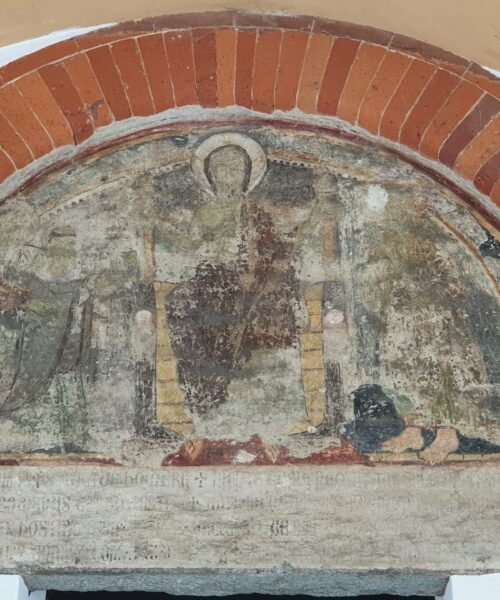Angelo Gilardino is a legendary figure who has illuminated the global musical landscape with a rare luminosity. Born in 1941 in Vercelli, but raised in Asigliano Vercellese, this artist and educator has left an indelible mark in the history of classical guitar and humanism. His skill in weaving together classicism and modern tones has made him an unparalleled figure.
From Early Steps in Vercelli to International Ascendancy
In the misty ambiance of Vercelli, a town where time seems to almost stand still, a young Angelo Gilardino discovers his refuge in the world of music. After experiencing the devastating loss of his father, his family decides to move, in search of new beginnings. Here, in the apparent quiet of a city distant from the nerve centers of Italian musical life, a journey of self-discovery begins that will take him far and wide.
While attending local music schools, Gilardino’s interest in music crystallizes into a true passion. He enthusiastically explores various instruments, from the cello to the guitar, but does not stop at mere execution. With insatiable curiosity, he dedicates himself to the study of composition, perhaps in an attempt to probe the mysteries of the universal language that is music.
In 1958, something extraordinary happens. His concert career, which until then had been a series of minor performances, suddenly takes flight. Angelo is no ordinary performer; from the earliest performances, he stands out for an almost prophetic sensitivity in repertoire selection. He focuses on contemporary and bold compositions, often on pieces written especially for him by composers who see in him not just a virtuoso, but an interpreter capable of bringing their works to life in the most complete manner.
With every new piece commissioned, with every masterful execution, his reputation grows. Soon, the name Angelo Gilardino becomes synonymous with a new type of guitarist: innovative, brave, and endowed with a rare talent for connecting the audience with the intricately nuanced contemporary music.
In hindsight, the years spent in Vercelli were not a period of isolation, but a necessary time for the incubation of a genuine talent. The town, with its slow pace and its serene atmosphere, provided the young Gilardino with the ideal place to grow both as an artist and as an individual. From those humble roots, in a small town far from the limelight, emerged a musician destined to change the sonic landscape of his era.
The Year of the Turning Point: The Evolution of a Master
In the distant year of 1981, Angelo Gilardino finds himself at a crossroads. With an already promising concert career underway, he faces a decision that might seem, in the eyes of the world, almost heretical: he decides to take a break from the limelight and the grand stages to devote himself to new, less flashy, but no less captivating fields of making music. It’s a courageous decision, laden with meaning, that opens a new phase in his artistic life.
With resolute determination, he turns to areas of music that he perceives need his attention and genius: composition, teaching, and musicology. It’s a return to roots, a sort of inner pilgrimage that leads him to the teaching chair, and to writing treatises aiming to fix theory and practice in a continuous and fruitful dialogue.
During the same period, Gilardino accepts the guitar teaching position at the renowned “Vivaldi” Conservatory of Alessandria. The news of his new appointment sends waves of excitement through the Italian musical world; students and colleagues understand the importance of having a master of such caliber within the institution’s walls. A few years later, moving further north, he takes on another significant educational role at the Lorenzo Perosi Academy in Biella.
These assignments are not merely jobs for him; they are rather missions. Here, he emphasizes the importance of the intimate relationship between theory and practice, encouraging students to explore the emotional depth of compositions while honing their technique. With one foot in the past and one facing the future, Gilardino leverages the academic positions to influence the next generation of musicians, instilling in them a love for the art that goes beyond mere virtuosity.
This period of intense academic activity continues until his definitive retirement from teaching in 2004. It’s not a silent farewell, but a mature and considered exit from the scene, leaving behind an indelible legacy. Students, colleagues, and music critics all feel the loss of his presence, but understand that his impact is destined to withstand the test of time.
For Angelo Gilardino, the year 1981 was not a moment of retreat, but a turning point, a bold step towards new horizons that expanded not only his world but also the musical landscape to which he dedicated his entire life.
The Artist and the Pedagogue
Angelo Gilardino was not merely a master at handling the guitar; he was an oracle of musical pedagogy. When you crossed the threshold of his classroom, you entered a learning ecosystem where every element was meticulously orchestrated to inspire and shape.
Students who were fortunate to call him a master found much more than a technical lesson: they found a journey. Over time, with Gilardino as their guide, they became fluent in a language far more complex and subtle than mere musical notation. They learned the language of music in all its infinite variations, a language that communicated not just with the mind, but reached deeply into the soul and heart.
In his lessons, Gilardino was accustomed to mixing theory and practice in a seductive cocktail of knowledge. Never was a mere technical exercise separated from the emotional or historical context in which it was born. For instance, if a pupil was studying a piece by Bach, the illustrious master might discuss the historical and cultural influences that shaped that composer, the historical period in which he lived, and how his work was placed in the broader fabric of the musical canon.
But his teaching went even further. Gilardino devoted himself to unveiling the intrinsic philosophy of each composition, instilling in his pupils a capacity for listening and interpretation that went beyond mere execution. He was a skilled communicator who knew when to push and when to give space, understanding that artistic growth requires both discipline and freedom.
The students, in turn, couldn’t help but feel a sense of responsibility toward the art they were learning to master. They knew they were not merely heirs to a tradition, but also bearers of a larger message: that music is a universal language, capable of speaking to anyone, regardless of origin or status.
In the hands of Angelo Gilardino, the art of teaching became an art form itself, a way to touch people’s lives in an irrevocable manner, leaving an indelible imprint not only on their skills but also on their souls.
Reclaiming the Past, Crafting the Future
Angelo Gilardino is not just a virtuoso of the guitar or an exceptional pedagogue; he is also an explorer of musical heritage, a man whose curiosity knows how to delve into the hidden meanderings of music history. His intellectual restlessness leads him to a sensational discovery: the original manuscript of Ottorino Respighi’s “Variations for Guitar,” an unfinished work that lay in the shadow of oblivion. This finding is not a fortuitous event, but the result of countless hours spent sifting through archives, studying ancient manuscripts, and dialoguing with colleagues and historians.
But Gilardino does not limit himself to bringing forgotten gems of the past to light; he also immerses himself in the creations of others. He discovers a vast corpus of compositions originally written for Andrés Segovia, the great Spanish guitarist and pioneer of modern classical guitar. In doing so, he not only pays homage to one of the most emblematic figures in the guitar world but also enriches the repertoire available for future generations of guitarists.
Yet, Gilardino is not content with being a mere musical archaeologist. His own creative output is equally prolific and influential. Take, for instance, his collection “Studies of Virtuosity and Transcendence,” a work that is not just a technical exercise but a profound reflection on the very nature of the guitar and its expressive potential. These studies are like sonic mosaics, each with its uniqueness, that test the guitarist’s skills while offering new horizons of interpretation.
In his hands, the role of the musicologist merges with that of the composer, creating an indissoluble bond between past, present, and future. Angelo Gilardino is not just a scholar or an artist, but a true custodian of musical heritage, a man who not only recovers what has been lost but also vigorously contributes to the weaving of the sonic tapestry that will continue to inspire for years to come.
Collaborations and Influences
Angelo Gilardino’s mastery does not remain confined to the narrow spaces of a concert hall or a conservatory classroom. His influence extends far beyond, thanks to collaborations with other eminent artists and musicians on the international scene. These artistic alliances are not mere exhibitions of virtuosity; rather, they represent an intertwining of cultures, styles, and traditions, a sort of intercultural dialogue set to music.
And this dialogue is not limited to geographical boundaries or musical genres. Gilardino becomes a global ambassador of guitar art through his international masterclasses. In these sessions, young talents and veterans of the instrument converge from distant corners of the world, each bringing along their own traditions and stylistic peculiarities. The class thus becomes a microcosm of diversity, where Gilardino serves as a catalyst, allowing participants to absorb new techniques and to see their art in a different light.
His performances and lessons are not just temporary meetings of creative minds; they become moments of authentic cultural exchange that elevate the art of guitar to a new global dimension. These events establish a universal language, where notes and melodies transcend linguistic and cultural barriers, creating a sonic bridge that unites people regardless of their origin.
Thus, Angelo Gilardino’s reach goes well beyond the sole guitar realm, permeating the entire fabric of the global musical community and enriching the art of guitar on a scale that goes well beyond national boundaries or musical genres.
Beyond Music: A Renaissance Man
The complexity of Angelo Gilardino is not limited to the perfection of his fingers on the fretboard or the depth of sound he evokes from the strings of his guitar. What sets him apart even more is his profile as a Renaissance man, a term that is not used lightly. Indeed, Gilardino is a man of eclectic culture, whose passions and interests extend well beyond the world of music.
On his shelves, next to the scores of Bach and the works of Segovia, one can find works of classic and modern literature, from Dante to Dostoevsky. They are not mere ornaments; they bear witness to his ongoing dialogue with the great thinkers and artists of the past and present. Gilardino regards literature as an essential supplement to his art, another vehicle that, like music, can explore the abysses of human experience and the existential condition.
His intellectual curiosity does not stop here. He has a deep love for the visual arts, particularly painting. In paintings, he sees a call to the aesthetics and emotion that also permeate his musical compositions. It’s not uncommon to hear him reference a painting during a lesson, using a work of art as a metaphor to express a musical nuance or concept that might otherwise be difficult to communicate.
And then there’s philosophy, that discipline that explores the great questions of existence, from meaning to morality. Gilardino does not merely skim it; he absorbs it, weighs it, discusses it. In his conversations and his lessons, philosophical thinkers find a place of honor, their ideas often intertwined with musical considerations in an amalgam that illuminates both fields.
In Gilardino, these various disciplines do not live in stagnant compartments, but merge into a holistic vision of life and art. To him, music is indissolubly linked to all these forms of expression and knowledge, converging to form a cultural and intellectual mosaic of extraordinary depth.
This is who Angelo Gilardino was: a virtuoso, certainly, but also a thinker, a philosopher, and an aesthete, whose deep humanity and vast culture make him a figure that transcends any label or category.
Angelo Gilardino: A Master in Art and Life
Angelo Gilardino was not simply a guitar teacher; he embodied the role of a master in every nuance of the term. For him, music transcended the barriers of mere technical competence. It wasn’t just about fingers flying on the strings or complex sequences of notes; it was about a dialogue with something greater, something eternal and infinite. For Gilardino, every chord, every arpeggio, every musical phrase was a passage towards a deeper understanding of human existence and the universe.
The lessons under his guidance were never just a technical exercise. They were rather a journey through the history of music, a philosophical meditation, a psychological exploration. Students left his classroom not only with a better mastery of the instrument, but also with a new perspective on life and art.
The world lost a giant when Angelo Gilardino left this earthly dimension in 2022. The news of his passing resonated like a dull thud in the hearts of anyone who knew him or had the privilege of being influenced by his art. But if his physical presence is no longer among us, his impact is anything but ephemeral.
Every time one of his compositions is performed, every time a student unfurls a flawless execution, every time a new piece of music comes to life on paper, it is as if another brick has been added to the imposing monument of his legacy. His name, his teachings, and his spirit will continue to shine like a beacon, illuminating the path of countless aspiring artists and musicians on their journey towards discovering the most authentic and profound essence of art.
His legacy is a continuously evolving mosaic, a collective work of art that continues to grow and evolve, testifying to the greatness of a man who knew how to touch not only the strings of a guitar but the strings of the human soul.












